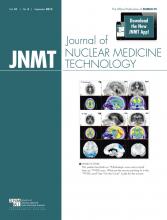
As I begin my year as SNMMI-TS president, I am excited to begin working with members, peer associations, health-care providers, and others to ensure that the field of nuclear medicine and molecular imaging continues to advance and to benefit patients. I hope to challenge technologists to expand their horizons and embrace the new opportunities available today.
My top priority as SNMMI-TS president is to facilitate the transition of new drugs and technologies into routine clinical practice, providing education and research opportunities for technologists. Over the past 18 months, we have had several new tracers and therapies approved by the U.S. Food and Drug Administration (FDA)—florbetapir for dementia imaging, 99mTc-tilmanocept injection for lymphatic mapping, and, most recently, 223Ra for the treatment of patients with castration-resistant prostate cancer. The role of technologists in the translation of these agents and therapies into clinical practice is an important one.
Education and professional development are critical to bringing technologists up to speed on the latest in their field. SNMMI has always provided high-quality education, and I will also focus my efforts in the coming year on ensuring that the Society offers continuing education and training opportunities that will fully prepare technologists to utilize new tracers, therapies, and modalities.
Regulations, both national and state-specific, also have a large impact on nuclear medicine and molecular imaging technology. In this leadership term year, SNMMI will take a more targeted approach and work with states that currently have no technologist licensing regulations to ensure quality in nuclear medicine and molecular imaging.
One regulatory issue of interest to nuclear medicine technologists is compounding for radiopharmaceuticals. In October 2012, there was an outbreak of fungal meningitis caused by contaminated injectable steroids manufactured by New England Compounding Center that killed more than 60 people and sickened nearly 750. This outbreak led to many questions regarding regulatory oversight and legal authority over compounding pharmacies.
Many nuclear medicine technologists currently compound radiopharmaceuticals according to practices established by U.S. Pharmacopeia Convention (USP) <797>—a general chapter in the USP that describes requirements for the preparation of sterile drugs, including radiopharmaceuticals. With the fallout from the fungal meningitis outbreak, nuclear medicine professionals were concerned that the compounding industry might become overregulated and, as an unintended consequence, block nuclear medicine technologists from compounding radiopharmaceuticals.
In recent months, SNMMI has met with members of Congress as well as the FDA to discuss compounding legislation and possible unintended consequences that would affect the members of the Society. In July, the U.S. House Energy and Commerce Committee’s health subcommittee held a hearing entitled, “Reforming the Drug Compounding Regulatory Framework.” Specifically, this hearing discussed proposed legislation introduced in response to the outbreak. Testimony was provided by representatives from several pharmacy associations.
There are currently 3 pieces of legislation being discussed in Congress. The Compounding Clarity Act, sponsored by Rep. Morgan Griffith (VA-9), seeks to clarify the authority of the states over compounding as compared with the authority of the FDA over manufacturing. H.R. 2186, the Verifying Authority and Legality in Drug Compounding Act of 2013, sponsored by Senator Ed Markey (MA), attempts to strengthen federal oversight of compounding pharmacies. Finally, S. 959, the Pharmaceutical Compounding Quality and Accountability Act, sponsored by Senator Tom Harkin (IA), draws a line between traditional compounders, which would be regulated primarily by state boards of pharmacy, and compounding manufacturers, which would be regulated by the FDA.
As the compounding issue continues to play out on the legislative and regulatory front, it is imperative that we continue to work with policy makers. It is our goal to inform their decision making to ensure our members maintain their ability to compound radiopharmaceuticals throughout the country.
I encourage all SNMMI-TS members to get involved, specifically on legislative affairs, and make their voices heard. The SNMMI-TS leadership strives to meet the needs of its members, and knowing what is important can help us set and accomplish goals to advance the profession.







